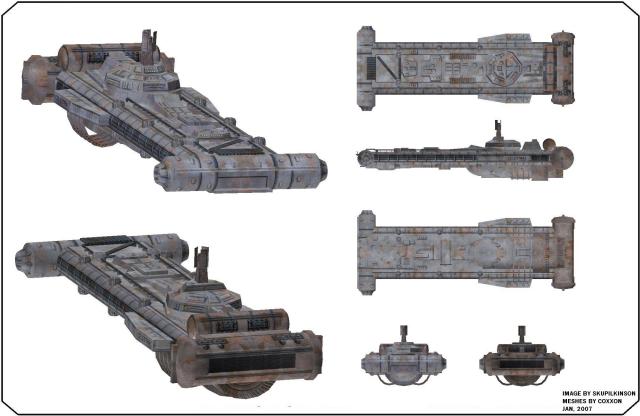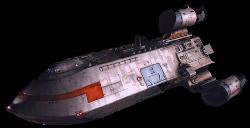
UGC Clariont Flag. | Toxic Waste Transfer Ships. | 
UGC Clariont Flag. |
|---|
To the left is a picture of a Celestra-Class Toxic Waste Transfer Ship. The picture is deceptive, in that this is the starboard side- The vsl shown is actually moving AWAY from the viewer, not towards. | The Toxic Waste Ship GSS Toxicity; She's Considered "A-Typical"
Because She's Kept Immaculately Clean- Even In Her Holds. |
|---|
 | | A Typical Toxic Waste Shuttle. |
|---|
Being a crewman on a toxic wastes ship is probably the safest job in the galaxies- And with good reason. Toxic wastes ships transport, as the name implies, transport materials so toxic they can't even be kept on an inhabited planet, PERIOD. Considering that nuclear wastes are considered "acceptable" wastes to keep on-planet, the implication is unavoidable.Amongst the other wastes carried by toxic wastes ships are decayed Detonex (used in anti-matter bombs), keriliium (a hypertoxic alloy of mercury and several other minerals, making it both metal and liquid; a byproduct of starship manufacturing, it seeps into EVERYTHING it touches, and is mildly acidic in its "stabilized" state, but wildly acidic before treatment), etc. Nobody- NOBODY- Raids a toxic wastes ship. In fact, even the most desperate pirates and malconts fear toxic waste ships; They'll call off an invasion, before they'll risk encountering a "dirty diaper boat."
Typically, these vsls collect containers in orbit around a waste producer, move on to the next site and repeat until the holds are filled, then head off to certain, pre-designated "dump sites," planets that can not be inhabited ever, where the sludges, powders, and etc. are very unceremoniously ejected and forgotten. The containers themselves are typically re-used, though some REALLY nasty materials contaminate even their containers so badly those must be ejected as well.Life for the crew of a toxic wastes ships is surprisingly good; Besides the fact that they have immediate access to a full surgeon (though often one who has lost their license), they receive pays more than ten TIMES the standard for their grade on any other type of ship, plus their accommodations are equal to those enjoyed by the Commanding Officers of Battlecarriers; Many such vsls are in fact family businesses, with two or three families banding together to build or buy one such vsl.Safety on these vsls are also far better than most other vsls; Better than passenger vsls, in fact. The absolute last ditch is to evacuate to the upper superstructure, then jettisoning; This then becomes a lifepod capable of handling a couple hundred passengers, with only a couple dozen at most. One such vsl is depicted to the right.Of special interest is the Celestra-Class, both because the UGC funds this design (subsidizing construction and operations costs) and for their unusual configuration; The Celestra-Class' docking bay is astern, rather than a bow or broadside, as is normally the case. This allows the Celestra-Class to operate with a wider variety of materials, and was accomplished because they do not use chemical thrusters for in-system propulsion, but rather a highly unique (singular, in fact) forward-mounted tractioning drive (a "puller" configuration); This also allows them to maneuver in more positional configurations, such as moving straight UP or DOWN, as it the dorsal/ventral aspects were swapped with the bow, much like space fighters are. (Under propulsion, below, disregard the rocket power entry; however, the Celestra-Class do use them for maneuvering.)Type: Toxic Wastes Ship.Class: There is no one class of toxic wastes ship; In fact, there are over 200 classes, most of which have less than a dozen vsls in the class. 99% are one of a kinds, of which about 1/3 are designed to carry one product to exclusion, and built for one owner company to carry their toxic wastes to exclusion.Crew: Very small; As little as 10 on "most" Toxic Waste Transfer Vsls.MDC By Location: |
Main Hull-
Bridge-
| Varies by ship; Generally 10,000.
Generally 1,000 Hull MDC.
| Hatches-
| Large through-hull hatches have 500 MDC, smaller internal hatches, doors, and scuttles generally only about 100. The exact number of hatches, doors, and scuttles vary, but two large through-hull hatches and 10-100 smaller, humanoid-sized through-hull hatches are common. |
| Speed and Statistical Data: |
Space Fold: Usually Equipped.
FTL: Factor 2- Thought they move from system to sytem quickly, they preffer to move VERY slowly through systems themselves.
Cruising Speed: Mach 5.
Clearance: Generally 1,000 feet.
Beam: Generally equal to the clearance.
Length: Generally 10,000 feet.
Weight: Generally about 1 million tons.
Cargo: Varies; Generally about 750,000 tons of toxic sludges; Because of the increased protections required to safely transport toxic wastes, they tend to carry less cargo than the ship's weight.
Propulsion:Primary: Tractioning drives.Secondary: Rocket power.
Cruise Duration: The cruise of a toxic wastes ship never really ends; They go from system to system, picking up the wastes until they get to the dump site. | Flight System: Standard grav pods; However. when ever practicable the ships simply drop waste containers onto the targeted planet/moon/etc and moving on.
Power Plant: Primary: Various nuclear reactors; Output varies greatly.Secondary: Solar panel arrays; Often used in place of the main power plant, since it's free, if circumstances permit. When otherwise, it is generally used only in emergencies.Tertiary: Battery back up. These are only used in GRAVE emergencies, but have a full six-week capability at basic life-support levels.
Cost and Availability: About 200,000,000credits to construct; Takes about 3 years to build.
Black Market Cost and Availability: Not available; Nobody would WANT one, with good reason.
|
| Weapons Systems:Because these ARE civilian vsls, they are rarely armed with anything but the most basic self-defense mechanisms. However, because of the nature of the cargo nobody would even try to fire on one of these vsls; This has actually been used by RDF's, throwing a toxic wastes vsl at attacking malconts to stall the assault. Though strictly illegal, there has never once been a successful prosecution for this tactic, and only a few dozen half-hearted ones. Quite a few reprimands for this tactic have ensued, however. |
1. Full-Force Barrier Field: This type of vsl generally has a full-force barrier field, but of the highest quality one.
MDC: Rarely lees than 500 per panel; As many as 20 panels.
Range: Self + about 100 feet.
Payload: Technically unlimited; However, the barrier field prevents ANY approach to the vsl, and therefore must be lowered to allow cargo shuttles, in.
Attacks Per Melee: Technically unlimited; Requires one melee action to raise, if the operator happens to be standing right there when the attack begins. Sadly, all too often they are not. | 2. Point Defense Lasers: These automated laser batteries kick in whenever the Collision alarm alerts. Rarely less than 200.
MD: 1D4 times 10 per blast.
Range: 100 feet.
Payload: Unlimited.
Attacks Per Melee: Twice per melee.
|
| Features: |
- 1 MC (loudspeaker): Internal loudspeaker.
- ESM: Radar Detector. Passively detects other radars being operated.
- AMC/FD (2): Anti-Missile Chaff/Flare Dispensers. Actually launches a glob of burning magnesium/aluminum alloy to confuse both radar AND heat sensory systems. Fires off 04 chaff/flares each time it is activated. The system is KNOWN to work on all KNOWN radar and infrared systems, but concerns continue that somewhere out there their MIGHT be a system that will be totally unaffected by the system. Reduce effects by 20% against smart missiles (add +20% to rolls for smart missiles).
- Effect:
- 01-50 Enemy missile or missile volley detonates in chaff cloud- Missiles are all destroyed.
- 51-
75 Enemy missile or missile volley loses track of real target and veers away in wrong direction (may lock onto another target).76-00 No effect, missile is still on target.- Also note that the chaff cloud will also blind nearby heat sensors (and optically based sensors at night) for 1 melee. They will suffer the following penalties: Reduce melee attacks/actions, and combat bonuses by half.
- Duration: 1D4 melee rounds.
- Payload: 120 chaff/flares. Each time the system is engaged, the system fires off 04 chaff/flares.
- Radar: Civilian grade radar. Range 1000 miles, can track up to 50 individual targets. 80% reliability (00% against unfriendly stealthed vehicles).
| - FLIR/SLIR: Forward and Side Looking Infrared. Allows crew to get visuals at night and in deep space.
- HUD: Displays maps, radar, targeting information, and any OTHER information the crew member wants directly in front of them.
- Virtual Map: Displays a continuously-updating map of all bodies ahead for the pilot. Takes data from and gives data to other ships in the area. Effective navigation of 85% as updates come. Good to 500 miles. Specific range can be adjusted in 1 mile increments.
- Video Camera: Records from the HUD. 50 hours of recording available.
- Full range optic sensory suite: Infrared, ultra violet, Magnification, night sight, color filters, thermal imager. Range is about 200 miles for MOST sensors.
- Escape Pods: There are supposed to be one 10-man pod per every 5 crewmembers; On a toxic wste transfer ship, there is one 10-man per PER CREWMAN.
- Survival Pack: A pack of simpler emergency survival supplies: Pup tent, sleeping bag, black light, GPS, first aid kit (bandages, gauze, bandage tape, pads, antiseptic/analgesic), plasma torch (for small repairs and starting fires), repair kit (with MDC Repair Spray), sewing kit (a small spool of thread and 5 needles),
7 star flares (250 foot apogee), 100 feet of black or brown parachute cord (150 lbs tensile strength; This is in addition to several hundred feet from their parachute itself), 2-5 days rations, 2 gallons water, water purification kit (good for about 10 gallons), manual-inflating liferaft (for at-sea abandonment), self-inflating lifevest (15# buoyancy). The liferaft can also double as a Pup Tent if so desired (though most pilots prefer to use a parachute for that, if anything, due to the fact that it is easier to hide). Typically kept with the escape pods. Note that a pup tent has very little use in hard vacuum, but can be handy if you crash land on a planet unexpectantly.
|
Combat Profile for an average Toxic Waste Transfer Ship:- 2 attacks per melee for automated laser batteries.
- 4 attacks per melee for the pilots (dodges/parries only)
- +3 to strike
- +2 to parry (only applies when actually underway, not when anchored)
- +2 to dodge (only applies when actually underway, not when anchored).
|